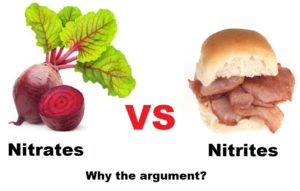
You may have come across warnings about consuming foods high in nitrates and/or nitrites, with respect to both animal- and plant-based foods. But what does the science say? Whilst previous blogs have touched on this subject – specifically in relation to chewing vs juicing 1 and whether athletic performance is affected by nitrate consumption 2 – here, the subject of dietary nitrates and nitrites is covered in more depth, to provide some clarity on which foods are to be avoided and which are to be embraced.
Blog Contents
Nitric Oxide – The Good Stuff
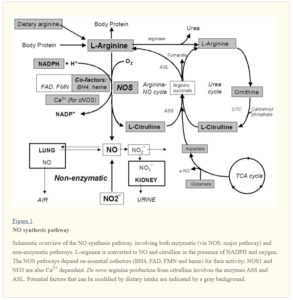
Really, this is all about a vital molecule called nitric oxide (with the chemical formula NO). In any list of the most important compounds within the human body, NO is right up there.
It’s so important because it gets involved in pretty much every single organ system within the body and has a central role as a major and powerful vasodilator. This means that it makes blood vessels wider – of immense importance in allowing the blood to flow without the heart having to strain.
There are a wide range of common diseases associated with insufficient NO, including:
- diabetes 3
- atherosclerosis 4
- cardiovascular disease 5
- stroke 6
- peripheral artery disease 7
- hyperlipidemia/hypercholesterolemia 8
- hypertension 9
- Alzheimer’s 10
- dementia 11
- depression 12
- psoriasis 13
- gout 14
- erectile dysfunction 15
- obstructive sleep apnea 16 17
The list goes on and on…really, it’s hard to over-estimate the importance of NO for human health.
But what have nitrates and nitrites got to do with nitric oxide?
Nitrates, Nitrites & Nitric Oxide

The above diagram 18 basically indicates that the body converts dietary nitrates to nitrites and then to NO (as well as to ammonia) 19 . During this process, an enzyme connected to the non-essential amino acid L-arginine (also just known as arginine) is required in order to produce NO from the nitrites. L-arginine is called ‘non-essential’ (or, more specifically, a ‘conditionally indispensable amino acid’) because, although it can be derived from foods, the body can also produce a certain amount of it. 20
L-arginine is found in many protein-containing foods, both animal- and plant-based 21 .
- Some animal foods high in L-arginine:
- turkey breast
- chicken
- pork loin
- beef
- Some plant foods high in L-arginine:
- leafy green vegetables 22
- nuts & seeds (pumpkin seeds, sesame seeds, walnuts, almonds, pine nuts)
- legumes (soybeans, chickpeas, peanuts)
- seaweed
- peanuts
- spinach
A problem with L-Arginine
Increasing age, smoking, high cholesterol, inflammation, dietary deficiencies and other factors can negatively affect the functioning of the enzyme required for this conversion of L-arginine to NO. And the problem of insufficient L-arginine is not solved by taking L-arginine supplements – indeed, L-arginine supplements have been shown, not only to be ineffective and even cause less NO to be produced 23 , but such supplements have led to increased mortality when given to patients who have had heart attacks :
“L-arginine, when added to standard postinfarction therapies, does not improve vascular stiffness measurements or ejection fraction and may be associated with higher postinfarction mortality. L-arginine should not be recommended following acute myocardial infarction.” 24 .
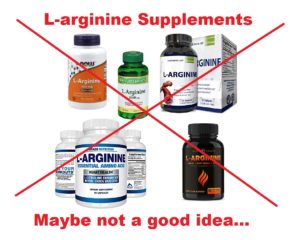
So what do we need to do to ensure that we have optimal NO levels?
First – A Bit of NO History
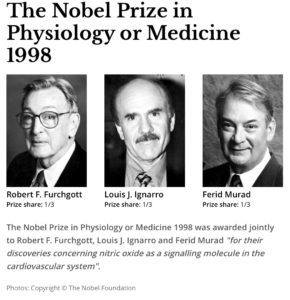
In 1987, Bob Furchgott 25 was the first to propose that NO was the EDRF (endothelium-derived relaxing factor) – i.e. that NO was the stuff responsible for the observed dilation of blood vessels, as well as a range of other vital physiological processes. Thus, NO is a relative newcomer to pharmacology. However, its impact was so significant that Bob Furchgott and his two collaborators, Louis J Ignarro and Ferid Murad, received the Nobel Prize in Physiology for its discovery.
Since then, hundreds of thousands of papers have been published with reference to NO – both in respect of NO as the endothelium-derived relaxing factor, as well as the role of L-arginine in NO synthesis.
During the time since 1987, the significance of the L-arginine:NO pathway has increased considerably – in relation to both the importance and the range of physiological roles this pathway plays. Roles which include:
- maintenance of vascular tone
- neurotransmitter function regulation in both the central and peripheral nervous systems
- mediation of cellular defence
- interaction within mitochondrial systems to:
- regulate cell respiration, and
- augment generation of reactive oxygen species, thereby
- triggering mechanisms of cell survival or death 26
Nitrates, Nitrites & Cancer
During this time, and until fairly recently, there was a particular concern about a potential increase in cancer risk from dietary nitrates and nitrites. This concern was accompanied by (and perhaps, to some extent, based on) the mistaken belief that the enzyme responsible for synthesising L-arginine within the body was the only pathway to produce NO in humans.
However, it’s been shown that when we ingest dietary nitrate, bacteria in the oral saliva convert it to nitrite. This nitrite is then swallowed and gets further converted into NO within the stomach, blood vessels and tissues 27 28 .
Mouthwashes, Antibiotics, Spitting & NO
We’ve looked previously 29 at the important role played by the bacteria in our mouths (the oral microbiome), and how it differs between meat- and plant-eaters. It’s important to stress that these oral bacteria are absolutely essential for the production of NO from our foods. Indeed, they are vital for this process, since humans can’t convert dietary nitrate to nitrite – it’s the bacteria living in our mouths that do the conversion.
So, predictably enough, it’s been shown 30 31 that, if you kill these oral bacteria by using an antibacterial mouthwash or taking antibiotics, the production of NO from dietary nitrate can stop completely. Additionally, if you spit a lot, you can deplete the bacterial concentration in your mouth, and this has a significant effect on nitrate conversion 28 .
Antacids & NO
Stomach acid also provides another important step in the production of NO from dietary nitrate 32 . Therefore, reducing the concentration of stomach acid by taking certain medication, including antacids and acid-reducing medications (such as Losec 33 ) can also decrease NO production and, thus, diminish its protective benefits 27 .
Quantity Matters
Today, dietary nitrate is understood as a highly significant precursor to NO in a dose-dependent manner 34 . So, the more nitrate consumed, the more NO becomes available in the body. There are, of course, upper limits, but these are only when nitrates are consumed in very large quantities, and this is unlikely (if even possible) from eating a WFPB diet – unless you’re unwise enough to take supplements.
Plant Nitrates vs Animal Nitrites
Plants are the primary source of dietary nitrates, while processed/cured meats are the primary sources of dietary nitrites (used as preservatives). It will comes as no surprise that the latter have a different impact on human health than the former.
Ingesting nitrates in plants increases NO and provides protective and healing benefits for a wide range of diseases characterised by insufficient NO (see the above list).
Ingesting nitrites in processed and cured meats (bacon, frankfurters, etc) can cause the nitrites to react with the amino acids, fat and haem iron already present within the meat, resulting in the formation of harmful substances before the meat is even cooked or eaten 35 36 .
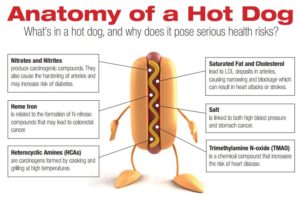
A previous blog 37 went into more detail on how meat preservation methods have led to such foods being classified as Group 1 carcinogens, along with tobacco and asbestos.
When nitrites are consumed in animal foods, they can form nitrosamines 38 39 – one of the carcinogenic agents also present in cigarette smoke. Nitrosamines in processed meats (smoked, canned and preserved), as well as in grilled meats, are formed from nitrites in the absence of phytonutrients and antioxidants found in plant foods. “Just a few hot dogs may contain the carcinogenic nitrosamine load of a pack of cigarettes. In fact, just the smell of frying bacon even contains nitrosamines.” 40 Indeed, whenever you consume a diet high in animal foods (whether it’s processed meats or organically-produced eggs or dairy), you’re consuming nitrites in the absence of the phytochemicals and antioxidants that only plants contain.
Athletic Performance, NO & ATP
A previous blog, which looked at the effects of NO on athletes 2 , emphasised how important NO is for optimal athletic performance and recovery. Basically, dietary nitrate in plant foods increases the diameter of blood vessels, thereby increasing the volume of blood moved around the body with each heartbeat. This increases oxygen production to the muscles and thus increases muscle strength.
Another aspect of the relationship of NO to physical activity is ATP (adenosine triphosphate) . ATP is produced when the food we’ve eaten is metabolised in the presence of oxygen 41 . ATP is within every cell of our bodies and produces the energy we need to survive and function. The more oxygen within our red blood cells, the more ATP can be produced and, thereby, the more energy we can have available to us. However, it’s not just a matter of being an athlete with bigger lungs that facilitates this; recent research has shown 42 that dietary nitrate can actually decrease the amount of oxygen you need in order to produce sufficient ATP – that is, more work can be performed using the same amount of oxygen inhaled. Dietary intake of nitrates appears to be particularly effective for short-term, high-intensity rather than long-term, less intensive exercise.
Dietary Nitrate & Mitochondria
Furthermore, it appears 43 that dietary nitrate also improves the efficiency of our mitochondria (the energy-producing powerhouses within every human cell). Thus, increased nitrate consumption can have significance for athletes, people who live at high altitudes (where oxygen levels are lower in the air), and people with certain oxygen-limited diseases (e.g. lung disease or sleep disorders) .
Research has shown 44 particular benefits of nitrate consumption for those individuals who have lower fitness levels and/or impairments related to their muscles, heart and/or lungs, for instance in cases of non-ischaemic, dilated cardiomyopathy 45 , COPD 46 , heart failure 47 , and peripheral artery disease 48 .
Blood Pressure & NO
There are few conditions that cause more chronic illness and early deaths than hypertension. And the increase in the number of people affected is clearly associated with the increase in prevalence of the Western diet – richer in animal foods and processed junk than any time in human history.
And it’s all connected to the function of NO. Since two of NO’s major functions are to maintain the health of the single layer of delicate endothelial cells lining our blood vessels, and to ensure that our blood vessels dilate effectively, any reduction in production of NO is bound to result in damage to the integrity and flexibility of the vessels.
It’s a matter of simple equations:
- increased plant foods + (decreased animal/processed foods) = increased dietary nitrates
- increased dietary nitrates = increased nitrite production in the body
- increased nitrite production in the body = increased NO
- increased NO = decreased blood pressure
- decreased NO = increased blood pressure
Even in early studies with young, healthy individuals, it’s been shown 49 50 that dietary nitrate-consumption decreases their blood pressure. More recent research also demonstrates 51 52 53 how it can also decrease blood pressure in those more at-risk populations who already have high blood pressure. One study 54 concluded: “an additional strategy, based on intake of nitrate-rich vegetables, may prove to be both cost-effective, affordable and favourable for a public health approach to hypertension.” Another study 55 showed how chronic OSA (obstructive sleep apnea) could be effectively treated by reducing blood pressure as a result of simply eating more dietary nitrates in plant-based foods. And research is starting to suggest 56 that brain disorders such as dementia, Alzheimer’s disease, etc may be helped by dietary nitrates helping to increase blood flow to the brain.
It took some time for scientists to be convinced that eating your veggies could really increase NO when other conventional therapies had continually failed to do so. But now, the sheer weight of research data supports this view – as one editor of an eminent journal stated 57 back in 2008: “Mother was right: eat your vegetables and do not spit!”
Long-Term vs Short-Term
As with most aspects of nutrition, doing the right thing for longer is more effective than doing it for shorter periods of time. This is no different with vegetable-consumption and NO production. It appears that the longer you eat a plant-based diet, the more beneficial the effects on your health. It makes sense, therefore, that transitioning to a life-long WFPB diet, rather than merely opting for a short period of relief from animal proteins (for instance, during Veganuary) and processed junk, is the way to enjoy maximum life-long benefits.
How Safe Is Dietary Nitrate?
Ingesting nitrates when they are inside vegetables is extremely safe, being that they are combined with fibre, antioxidants and phytochemicals. Having said this, infants under the age of three months should not be given dietary nitrates – that is, not fed vegetables 58 . This shouldn’t even be an issue since, as we saw in a highly-detailed previous blog on Vegan Pregnancy & Parenting 59 , all babies of this age should only be receiving breast milk or, if that is not available, appropriate formula milk.
Also, for those taking particular medications (including blood-thinning drugs like Warfarin), the high levels of vitamin K (phylloquinone) in green vegetables can be a potential issue, since vitamin K’s blood-clotting action can reduce the required actions of the prescribed drug. As Dr Greger says 60 : “In fact dark green leafies are so packed with vitamin K that if you’re on the drug coumadin (warfarin), a drug that works by poisoning vitamin K metabolism, you have to closely work with your physician to titrate the dose to your greens intake so as to not undermine the drug’s effectiveness!”
How To Increase Nitrate Intake
Although there is some variation in levels (depending on plant type and the quality of the soil used for growing), it’s important to understand that all whole plant foods contain nitrates. Whilst around 85% of nitrates will come from the plants you eat, around 15% is actually contained in the water you drink 61 .
Green, Leafy Veg
Research indicates 62 63 that green, leafy veg have the highest levels of nitrates:
- rocket (arugula in the US)
- cabbage
- lettuce
- chard
- beetroot and rhubarb have moderate amounts
- carrots and other veg contain lesser amounts
USA & European Nitrate Consumption
Surveys of dietary habits in the US and Europe show 64 51 low levels of daily nitrate intake (~0.5-3 mmol/day), which is consistent with the low levels of vegetable consumption. All diets which tend to contain more vegetables (such as Japanese diets, the DASH diet, vegetarian and vegan diets), all show 65 a higher amount of nitrate intake (~20 mmol/day) than standard Western diets.
Regular & Sufficient Nitrates
The positive effects of dietary nitrate don’t last for ever. The peak effectiveness appears to be 28 at around three hours after consumption. There’s still some benefit after this point, but after 24 hours the effect of the nitrate is virtually nil. Thus, the ideal diet would consist of nitrate-rich foods being consumed at least a couple of times each day.
In terms of nitrate quantity, one study suggests 66 that 8.4-16.8 mmol/day produces the greatest improvement in NO utilisation (and, hence, in exercise performance), while 4.2 mmol/day produces little or no effect and anything above 16.8 mmol/day appears to achieve no additional benefits. The suggestion is that maximum benefit is achieved with ~10 mmol/day – quite manageable by eating a moderate amount of varied plant foods (green leafy veg, beetroot, rhubarb, etc). Exercise is also reported to increase NO production.
Final thoughts
Whatever you may have heard to the contrary, the consistent scientific consensus is that green, leafy veg are one of the healthiest foods on the planet for humans, and many authorities maintain 67 68 28 that the NO-producing nitrates in those veg accounts for a lot of these health benefits. 69
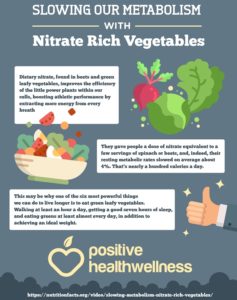
Finally, how better to finish than a short video by Dr Michael Greger?
References
- Greens: Chewing vs Juicing [↩]
- Which Athlete Ate the Most Nitrates… [↩] [↩]
- Diabetes. 2010 Sep; 59(9): 2152–2159. Nitric Oxide Synthesis Is Reduced in Subjects With Type 2 Diabetes and Nephropathy. Paolo Tessari, Diego Cecchet, Alessandra Cosma, Monica Vettore, Anna Coracina, Renato Millioni, Elisabetta Iori, Lucia Puricelli, Angelo Avogaro, and Monica Vedovato. [↩]
- Nitric Oxide. 2006 Dec;15(4):265-79. Epub 2006 Apr 15. Nitric oxide and atherosclerosis: an update. Napoli C, de Nigris F, Williams-Ignarro S, Pignalosa O, Sica V, Ignarro LJ. [↩]
- Mol Aspects Med. 2005 Feb-Apr;26(1-2):33-65. Epub 2005 Jan 24. The role of nitric oxide in cardiovascular diseases. Naseem KM. [↩]
- Med Gas Res. 2017 Jul-Sep; 7(3): 194–203. The role of nitric oxide in stroke. Zhou-qing Chen, Ru-tao Mou, Dong-xia Feng, Zhong Wang, M.D., and Gang Chen, M.D., Ph.D. [↩]
- Nitric Oxide. 2012 May 15; 26(4): 217–222. Nitrite and Nitric Oxide Metabolism in Peripheral Artery Disease. Jason D. Allen, Tony Giordano, and Christopher G. Kevil. [↩]
- Atherosclerosis. April 1998. Volume 137, Supplement 1, Pages S51–S60. Nitric oxide and hypercholesterolemia: a matter of oxidation and reduction? Robert Wever, Erik Stroes, Ton J Rabelink [↩]
- J Clin Hypertens (Greenwich). 2006 Dec;8(12 Suppl 4):17-29. Nitric oxide in hypertension.
Hermann M, Flammer A, Lüscher TF. [↩] - Neurol Res. 2004 Jul;26(5):563-6. Nitric oxide pathways in Alzheimer’s disease and other neurodegenerative dementias. Togo T1, Katsuse O, Iseki E. [↩]
- Brain Research Reviews. Volume 35, Issue 1, March 2001, Pages 73-96. Say NO to Alzheimer’s disease: the putative links between nitric oxide and dementia of the Alzheimer’s type. A.Law, S.Gauthier, R.Quirion. [↩]
- Nitric Oxide. 2011 Apr 30;24(3):125-31. doi: 10.1016/j.niox.2011.02.002. Epub 2011 Feb 16. Nitric oxide and major depression. Dhir A, Kulkarni SK. [↩]
- Georgian Med News. 2014 Sep;(234):61-4. The role of nitric oxide in the pathogenesis and severity of psoriasis. Matoshvili M, Katsitadze A, Sanikidze T, Tophuria D, Richetta A, D’Epiro S. [↩]
- Nucleosides Nucleotides Nucleic Acids. Author manuscript; available in PMC 2009 Jun 24. Inactivation of Nitric Oxide by Uric Acid. Christine Gersch, Sergiu P. Palii, Kyung Mee Kim, Alexander Angerhofer, Richard J. Johnson, and George N. Henderson. [↩]
- J Clin Hypertens (Greenwich). 2006 Dec;8(12 Suppl 4):53-62. The role of nitric oxide in erectile dysfunction: implications for medical therapy. Burnett AL. [↩]
- Sleep Disord. 2015; 2015: 387801. Nitric Oxide Bioavailability in Obstructive Sleep Apnea: Interplay of Asymmetric Dimethylarginine and Free Radicals. Mohammad Badran, Saeid Golbidi, Najib Ayas, Ismail Laher. [↩]
- Obstructive Sleep Apnea (OSA) & Gut Microbiota [↩]
- Curr Opin Clin Nutr Metab Care. 2010 Jan; 13(1): 97–104. REGULATION OF NITRIC OXIDE PRODUCTION IN HEALTH AND DISEASE. Yvette C. Luiking, PhD, Mariëlle P.K.J. Engelen, PhD, and Nicolaas E.P. Deutz, MD, PhD [↩]
- PLoS One. 2015 Mar 24;10(3):e0119712. doi: 10.1371/journal.pone.0119712. eCollection 2015. Nitrate reduction to nitrite, nitric oxide and ammonia by gut bacteria under physiological conditions. Tiso M, Schechter AN. [↩]
- More on L-arginine and NO synthesis: Another amino acid, L-citrulline, found in watermelons and also produced in the body, is an endogenous precursor for L-arginine. The family of enzymes involved in L-arginine synthesis – the NO synthases (NOSs, EC 1.14.13.39) – catalyse the oxidation of L-arginine (Arg) to NO and l-citrulline, with NADPH and O2 serving as cosubstrates (Alderton, R. K., Cooper, C. E. & Knowles, R. G. (2001) Nitric oxide synthases: structure, function and inhibition. Biochem. J. 357(pt. 3):593–615.). The NOSs first hydroxylate a terminal guanidino nitrogen of Arg to generate N-hydroxy-l-arginine (NOHA) as an enzyme-bound intermediate. NOHA is then oxidized further by the enzyme to generate NO plus l-citrulline. [↩]
- MedicalNewsToday: Which foods are high in arginine? [↩]
- Afr J Tradit Complement Altern Med. 2017; 14(3): 31–41. NITRATE IN LEAFY GREEN VEGETABLES AND ESTIMATED INTAKE. Danijel Brkić, Jasna Bošnir, Martina Bevardi, Andrea Gross Bošković, Sanja Miloš, Dario Lasić, Adela Krivohlavek, Aleksandar Racz, Ana Mojsović Ćuić, Natalija Uršulin Trstenjak. [↩]
- Wilson AM, Harada R, Nair N, Balasubramanian N, Cooke JP. L-arginine supplementation in peripheral arterial disease: no benefit and possible harm. Circulation. 2007 Jul 10;116(2):188-95. Epub 2007 Jun 25. [↩]
- Schulman SP, Becker LC, Kass DA, Champion HC, Terrin ML, Forman S, Ernst KV, Kelemen MD, Townsend SN, Capriotti A, Hare JM, Gerstenblith G. L-arginine therapy in acute myocardial infarction: the Vascular Interaction With Age in Myocardial Infarction (VINTAGE MI) randomized clinical trial. JAMA. 2006 Jan 4;295(1):58-64.Lundberg et al 1994 [↩]
- Br J Pharmacol. 2009 Oct; 158(3): 633–637. Robert F. Furchgott, Nobel laureate (1916–2009) – a personal reflection. William Martin. [↩]
- Br J Pharmacol. 2006 Jan; 147(Suppl 1): S193–S201. Published online 2006 Jan 9. doi: 10.1038/sj.bjp.0706458. The discovery of nitric oxide and its role in vascular biology. S Moncada, E A Higgs. [↩]
- Lundberg JO, Weitzberg E, Lundberg JM, Alving K. Intragastric nitric oxide production in humans: measurements in expelled air. Gut. 1994 Nov;35(11):1543-6. [↩] [↩]
- Webb AJ, Patel N, Loukogeorgakis S, Okorie M, Aboud Z, Misra S, Rashid R, Miall P, Deanfield J, Benjamin N, MacAllister R, Hobbs AJ, Ahluwalia A. Acute blood pressure lowering, vasoprotective, and antiplatelet properties of dietary nitrate via bioconversion to nitrite. Hypertension. 2008 Mar;51(3):784-90. doi: 10.1161/HYPERTENSIONAHA.107.103523. Epub 2008 Feb 4. [↩] [↩] [↩] [↩]
- Oral Microbiota – Meat-Eaters & Plant-Eaters [↩]
- Bondonno CP, Liu AH, Croft KD, Considine MJ, Puddey IB, Woodman RJ, Hodgson JM. Antibacterial mouthwash blunts oral nitrate reduction and increases blood pressure in treated hypertensive men and women. Am J Hypertens. 2015 May;28(5):572-5. doi: 10.1093/ajh/hpu192. Epub 2014 Oct 30. [↩]
- Bryan NS, Tribble G, Angelov N. Oral Microbiome and Nitric Oxide: the Missing Link in the Management of Blood Pressure. Curr Hypertens Rep. 2017 Apr;19(4):33. doi: 10.1007/s11906-017-0725-2. Review. [↩]
- Digital Comprehensive Summaries of Uppsala Dissertations from the Faculty of Medicine 328. Nitrate, Nitrite and Nitric Oxide
in Gastric Mucosal Defense. JOEL PETERSSON. [↩] - MedBroadcast: Losec -omeprazole [↩]
- Bondonno CP, Croft KD, Puddey IB, Considine MJ, Yang X, Ward NC, Hodgson JM. Nitrate causes a dose-dependent augmentation of nitric oxide status in healthy women. Food Funct. 2012 May;3(5):522-7. doi: 10.1039/c2fo10206d. Epub 2012 Feb 16. [↩]
- Haorah J, Zhou L, Wang X, Xu G, Mirvish SS. Determination of total N-nitroso compounds and their precursors in frankfurters, fresh meat, dried salted fish, sauces, tobacco, and tobacco smoke particulates. J Agric Food Chem. 2001 Dec;49(12):6068-78. [↩]
- Campillo N, Viñas P, Martínez-Castillo N, Hernández-Córdoba M. Determination of volatile nitrosamines in meat products by microwave-assisted extraction and dispersive liquid-liquid microextraction coupled to gas chromatography-mass spectrometry. J Chromatogr A. 2011 Apr 8;1218(14):1815-21. doi: 10.1016/j.chroma.2011.02.010. Epub 2011 Feb 13. [↩]
- Food Processing & Preserving Causes Cancer [↩]
- Nutrients. 2015 Dec; 7(12): 9872–9895.Dietary Nitrates, Nitrites, and Nitrosamines Intake and the Risk of Gastric Cancer: A Meta-Analysis. Peng Song, Lei Wu, Wenxian Guan. [↩]
- ScienceDirect: Nitrosamines are potent pancreatic carcinogens in animal models, and levels of NNK in samples of human pancreatic juice are significantly higher in smokers than nonsmokers. (Prokopczyk et al., 2002.) . From: International Encyclopedia of Public Health, 2008. [↩]
- Nutritionfacts: Nitrosamines.
Topic summary contributed by John. [↩] - Nitric Oxide. 2002 Feb;6(1):45-60. Nitric oxide and differential effects of ATP on mitochondrial permeability transition. Piantadosi CA, Tatro LG, Whorton AR. [↩]
- Bailey SJ, Winyard P, Vanhatalo A, Blackwell JR, Dimenna FJ, Wilkerson DP, Tarr J, Benjamin N, Jones AM. Dietary nitrate supplementation reduces the O2 cost of low-intensity exercise and enhances tolerance to high-intensity exercise in humans. J Appl Physiol (1985). 2009 Oct;107(4):1144-55. doi: 10.1152/japplphysiol.00722.2009. Epub 2009 Aug 6. [↩]
- Larsen FJ, Schiffer TA, Borniquel S, Sahlin K, Ekblom B, Lundberg JO, Weitzberg E. Dietary inorganic nitrate improves mitochondrial efficiency in humans. Cell Metab. 2011 Feb 2;13(2):149-59. doi: 10.1016/j.cmet.2011.01.004. [↩]
- Kerley CP. Dietary nitrate as modulator of physical performance and cardiovascular health. Curr Opin Clin Nutr Metab Care. 2017 Nov;20(6):440-446. doi: 10.1097/MCO.0000000000000414. [↩]
- Kerley CP, O’Neill JO, Reddy Bijjam V, Blaine C, James PE, Cormican L. Dietary nitrate increases exercise tolerance in patients with non-ischemic, dilated cardiomyopathy-a double-blind, randomized, placebo-controlled, crossover trial. J Heart Lung Transplant. 2016 Jul;35(7):922-6. doi: 10.1016/j.healun.2016.01.018. Epub 2016 Jan 16. [↩]
- Kerley CP, Cahill K, Bolger K, McGowan A, Burke C, Faul J, Cormican L. Dietary nitrate supplementation in COPD: an acute, double-blind, randomized, placebo-controlled, crossover trial. Nitric Oxide. 2015 Jan 30;44:105-11. doi: 10.1016/j.niox.2014.12.010. Epub 2014 Dec 19. [↩]
- Coggan AR, Leibowitz JL, Spearie CA, Kadkhodayan A, Thomas DP, Ramamurthy S, Mahmood K, Park S, Waller S, Farmer M, Peterson LR. Acute Dietary Nitrate Intake Improves Muscle Contractile Function in Patients With Heart Failure: A Double-Blind, Placebo-Controlled, Randomized Trial. Circ Heart Fail. 2015 Sep;8(5):914-20. [↩]
- Kenjale AA, Ham KL, Stabler T, Robbins JL, Johnson JL, Vanbruggen M, Privette G, Yim E, Kraus WE, Allen JD. Dietary nitrate supplementation enhances exercise performance in peripheral arterial disease. J Appl Physiol (1985). 2011 Jun;110(6):1582-91. doi: 10.1152/japplphysiol.00071.2011. Epub 2011 Mar 31. [↩]
- Hobbs DA, George TW, Lovegrove JA. The effects of dietary nitrate on blood pressure and endothelial function: a review of human intervention studies. Nutr Res Rev. 2013 Dec;26(2):210-22. doi: 10.1017/S0954422413000188. Epub 2013 Oct 18. Review. [↩]
- Siervo M, Lara J, Ogbonmwan I, Mathers JC. Inorganic nitrate and beetroot juice supplementation reduces blood pressure in adults: a systematic review and meta-analysis. J Nutr. 2013 Jun;143(6):818-26. doi: 10.3945/jn.112.170233. Epub 2013 Apr 17. Review. [↩]
- Ghosh SM, Kapil V, Fuentes-Calvo I, Bubb KJ, Pearl V, Milsom AB, Khambata R, Maleki-Toyserkani S, Yousuf M, Benjamin N, Webb AJ, Caulfield MJ, Hobbs AJ, Ahluwalia A. Enhanced vasodilator activity of nitrite in hypertension: critical role for erythrocytic xanthine oxidoreductase and translational potential. Hypertension. 2013 May;61(5):1091-102. doi: 10.1161/HYPERTENSIONAHA.111.00933. Epub 2013 Apr 15. [↩] [↩]
- Kerley CP, Cormican L, James PE, Dolan, E. Dietary nitrate lowers ambulatory blood pressure in treated, uncontrolled hypertension: a 7d, double-blind, randomized, placebo-controlled, crossover trial. [↩]
- Kerley CP, Dolan E, Cormican L. Nitrate-rich beetroot juice selectively lowers ambulatory pressures and LDL cholesterol in uncontrolled but not controlled hypertension: a pilot study. Ir J Med Sci. 2017 Nov;186(4):895-902. [↩]
- Kapil V, Khambata RS, Robertson A, Caulfield MJ, Ahluwalia A. Dietary nitrate provides sustained blood pressure lowering in hypertensive patients: a randomized, phase 2, double-blind, placebo-controlled study. Hypertension. 2015 Feb;65(2):320-7. doi: 10.1161/HYPERTENSIONAHA.114.04675. Epub 2014 Nov 24. [↩]
- Kerley CP, Dolan E, Cormican L. Dietary nitrate decreased blood pressure in obstructive sleep apnoea syndrome: a series of N-of-1 trials. J Hypertens. 2016 Apr;34(4):808-10. doi: 10.1097/HJH.0000000000000858. [↩]
- Presley TD, Morgan AR, Bechtold E, Clodfelter W, Dove RW, Jennings JM, Kraft RA, King SB, Laurienti PJ, Rejeski WJ, Burdette JH, Kim-Shapiro DB, Miller GD. Acute effect of a high nitrate diet on brain perfusion in older adults. Nitric Oxide. 2011 Jan 1;24(1):34-42. doi: 10.1016/j.niox.2010.10.002. Epub 2010 Oct 15. [↩]
- Wink DA, Paolocci N. Mother was right: eat your vegetables and do not spit! When oral nitrate helps with high blood pressure. Hypertension. 2008 Mar;51(3):617-9. doi: 10.1161/HYPERTENSIONAHA.107.106617. Epub 2008 Feb 4. [↩]
- Greer FR, Shannon M; American Academy of Pediatrics Committee on Nutrition; American Academy of Pediatrics Committee on Environmental Health. Infant methemoglobinemia: the role of dietary nitrate in food and water. Pediatrics. 2005 Sep;116(3):784-6. [↩]
- Vegan Pregnancy & Parenting [↩]
- What are the best sources of vitamin K? Written By Michael Greger M.D. FACLM on November 8th, 2012 [↩]
- Lundberg JO, Weitzberg E, Gladwin MT. The nitrate-nitrite-nitric oxide pathway in physiology and therapeutics. Nat Rev Drug Discov. 2008 Feb;7(2):156-67. [↩]
- Evaluation of the Nitrate and Nitrite Content of Vegetables Commonly Grown in Slovenia. Veronika Kmecl. Tea Knap. Dragan Žnidarčič. Article Jun 23 2017. DOI: 10.4081/ija.2017.801 [↩]
- ResearchGate: Nitrate in fruits and vegetables. Article (PDF Available) in Scientia Horticulturae 237:221-238 · July 2018. [↩]
- Gangolli SD, van den Brandt PA, Feron VJ, Janzowsky C, Koeman JH, Speijers GJ, Spiegelhalder B, Walker R, Wisnok JS. Nitrate, nitrite and N-nitroso compounds. Eur J Pharmacol. 1994 Nov 1;292(1):1-38. Review. [↩]
- Sobko T, Marcus C, Govoni M, Kamiya S. Dietary nitrate in Japanese traditional foods lowers diastolic blood pressure in healthy volunteers. Nitric Oxide. 2010 Feb 15;22(2):136-40. doi: 10.1016/j.niox.2009.10.007. Epub 2009 Nov 1 [↩]
- Wylie LJ, Mohr M, Krustrup P, Jackman SR, Ermιdis G, Kelly J, Black MI, Bailey SJ, Vanhatalo A, Jones AM. Dietary nitrate supplementation improves team sport-specific intense intermittent exercise performance. Eur J Appl Physiol. 2013 Jul;113(7):1673-84. doi: 10.1007/s00421-013-2589-8. Epub 2013 Feb 1. [↩]
- Lundberg JO, Feelisch M, Björne H, Jansson EA, Weitzberg E. Cardioprotective effects of vegetables: is nitrate the answer? Nitric Oxide. 2006 Dec;15(4):359-62. Epub 2006 Mar 24. [↩]
- Ralt D. Does NO metabolism play a role in the effects of vegetables in health? Nitric oxide formation via the reduction of nitrites and nitrates. Med Hypotheses. 2009 Nov;73(5):794-6. doi: 10.1016/j.mehy.2009.03.049. Epub 2009 May 27. [↩]
- Special thanks to Conor Kerley PhD, writing on behalf of CNS, for his article “Nitric Oxide & Dietary Nitrate: Another Reason to Eat Your Vegetables”, December 13, 2017. [↩]